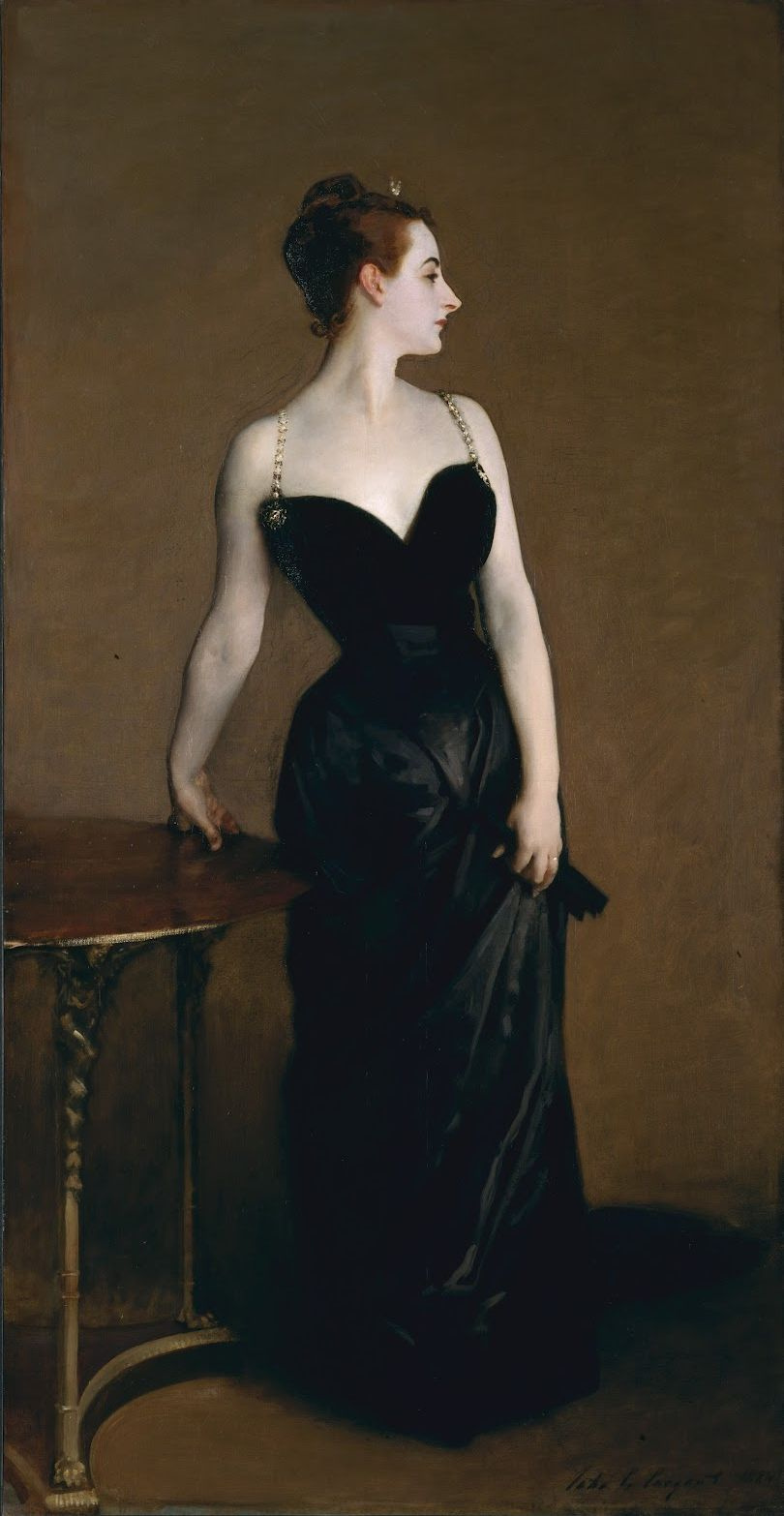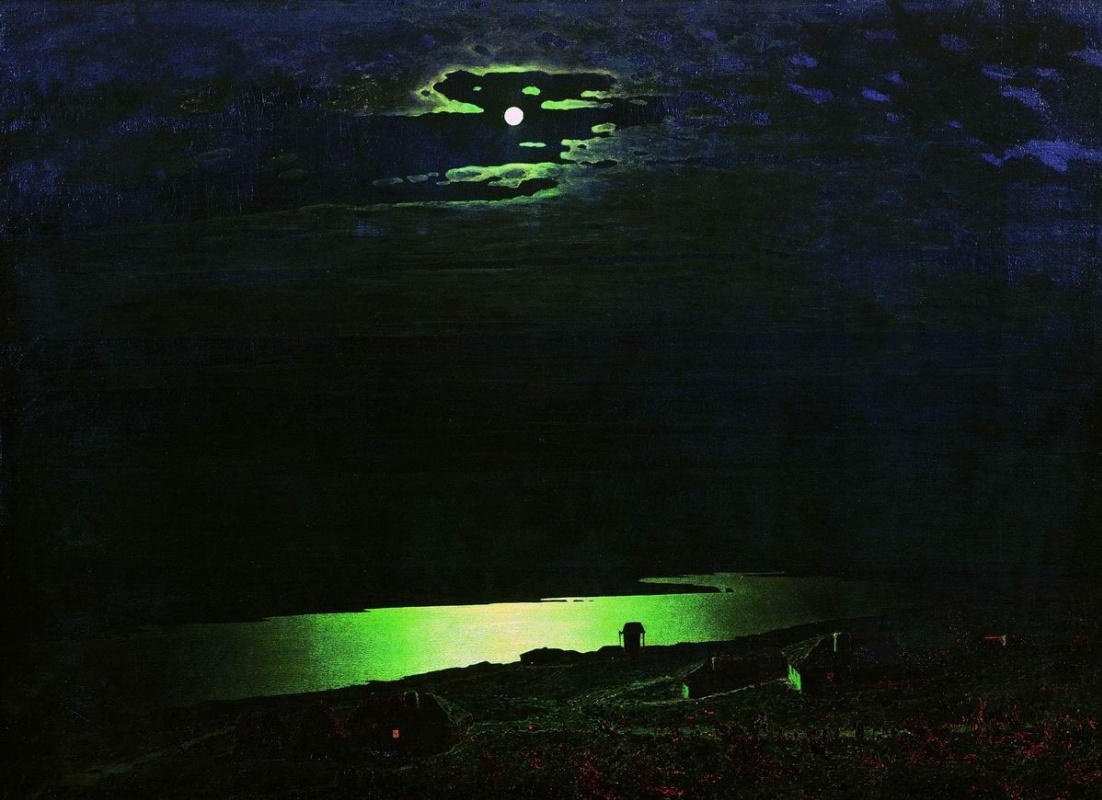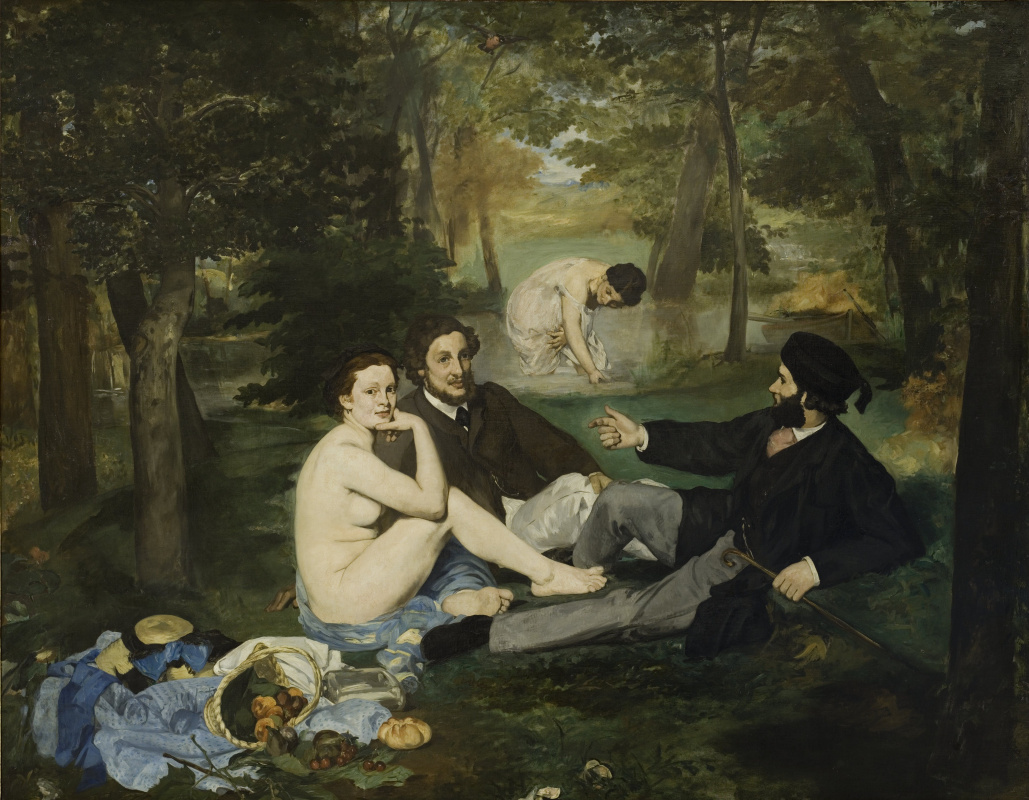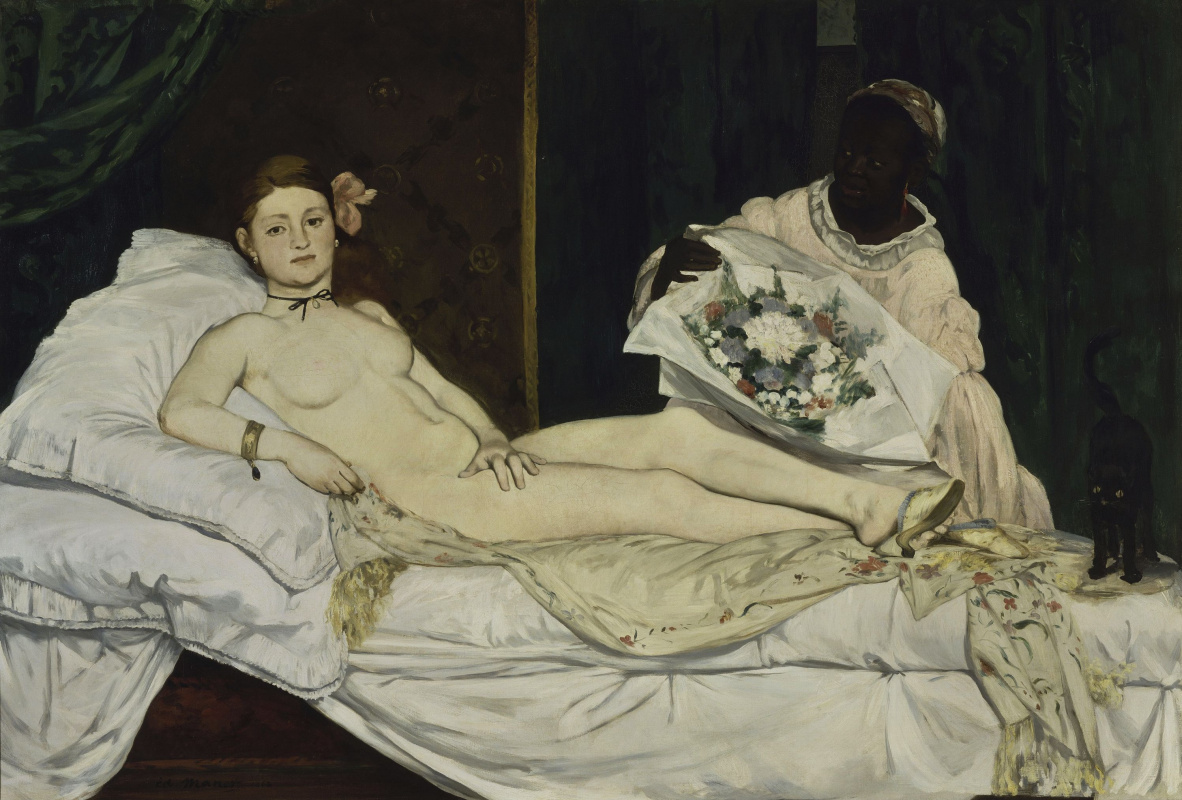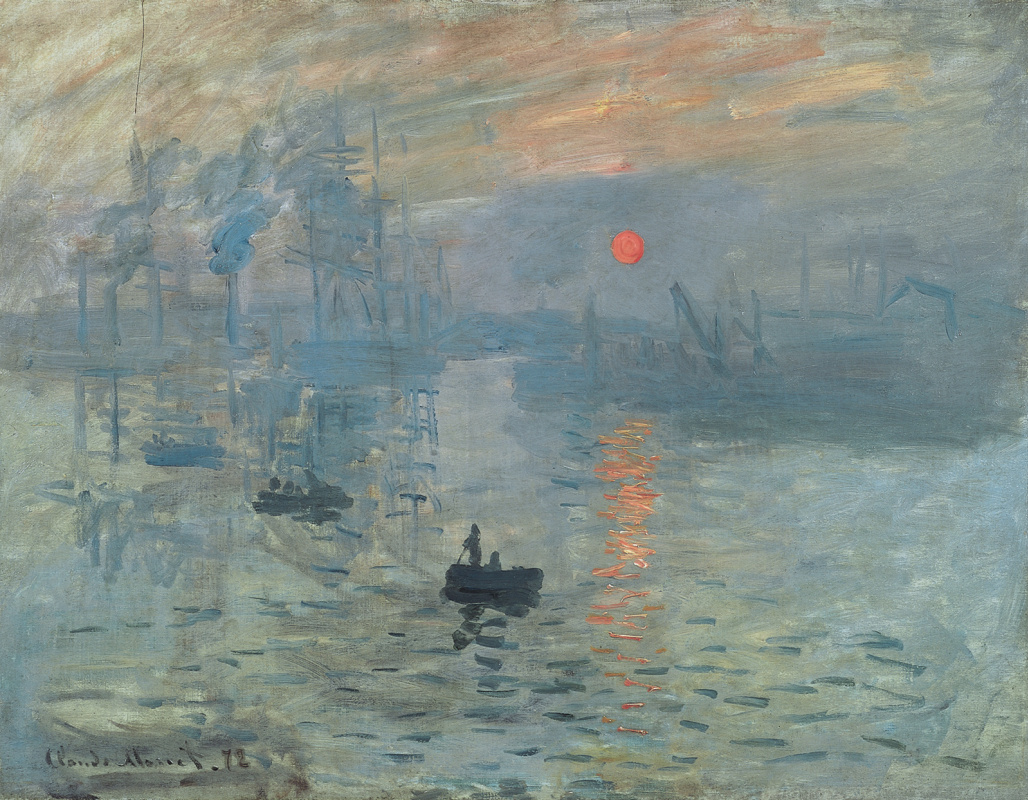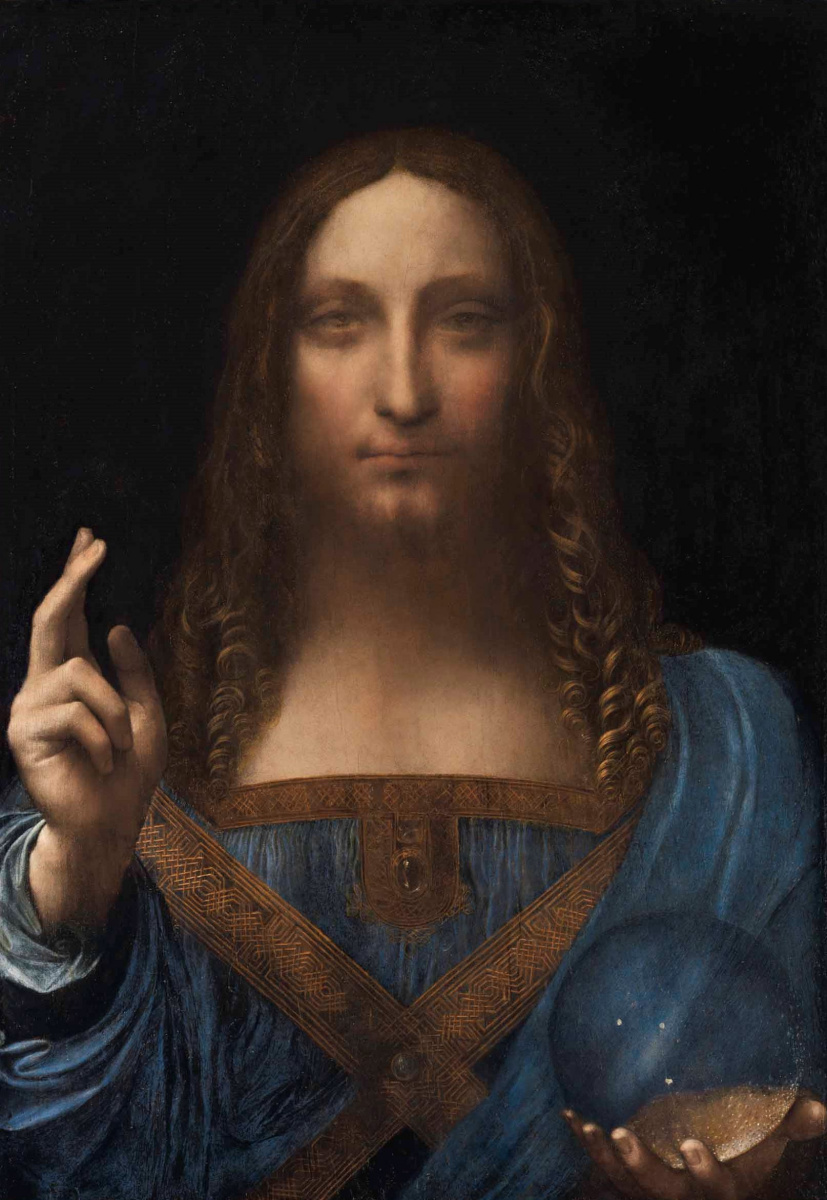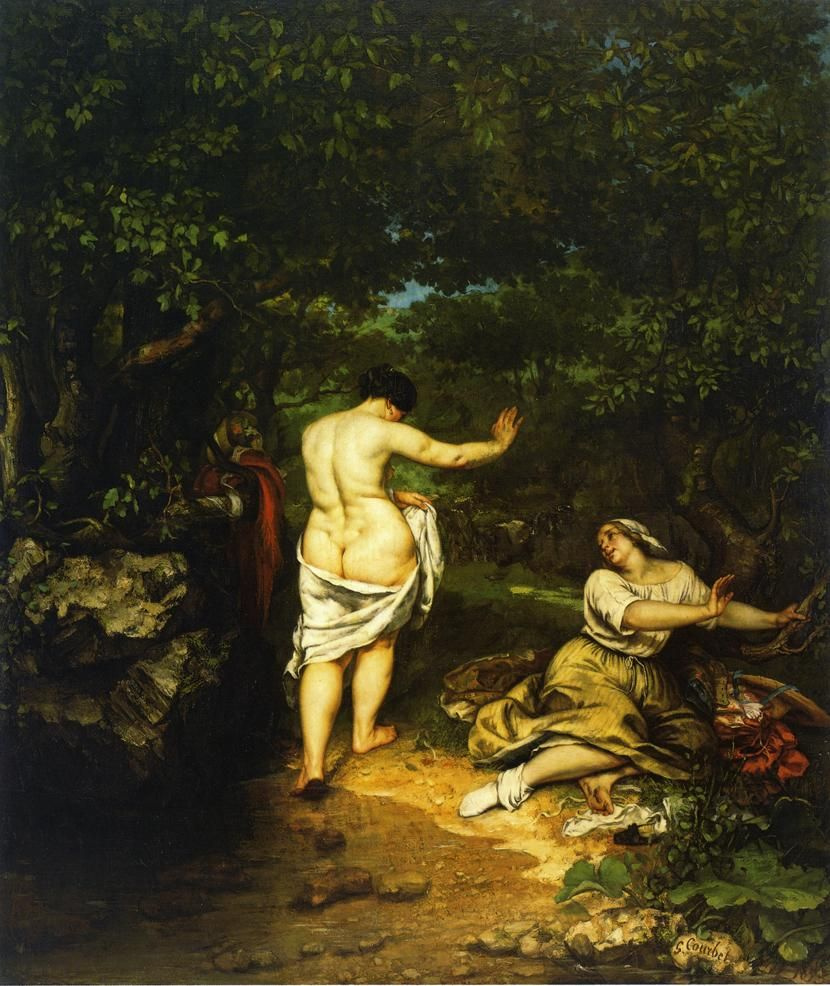The angry press, furious audience, kilometer-long lines for the exhibition, record auction prices — the hype around the paintings can spoil the artist’s nerves or make him famous and demanded. Arthive tells you about the scandalous past of eight masterpieces and about the artists who were able to benefit from the scandals.
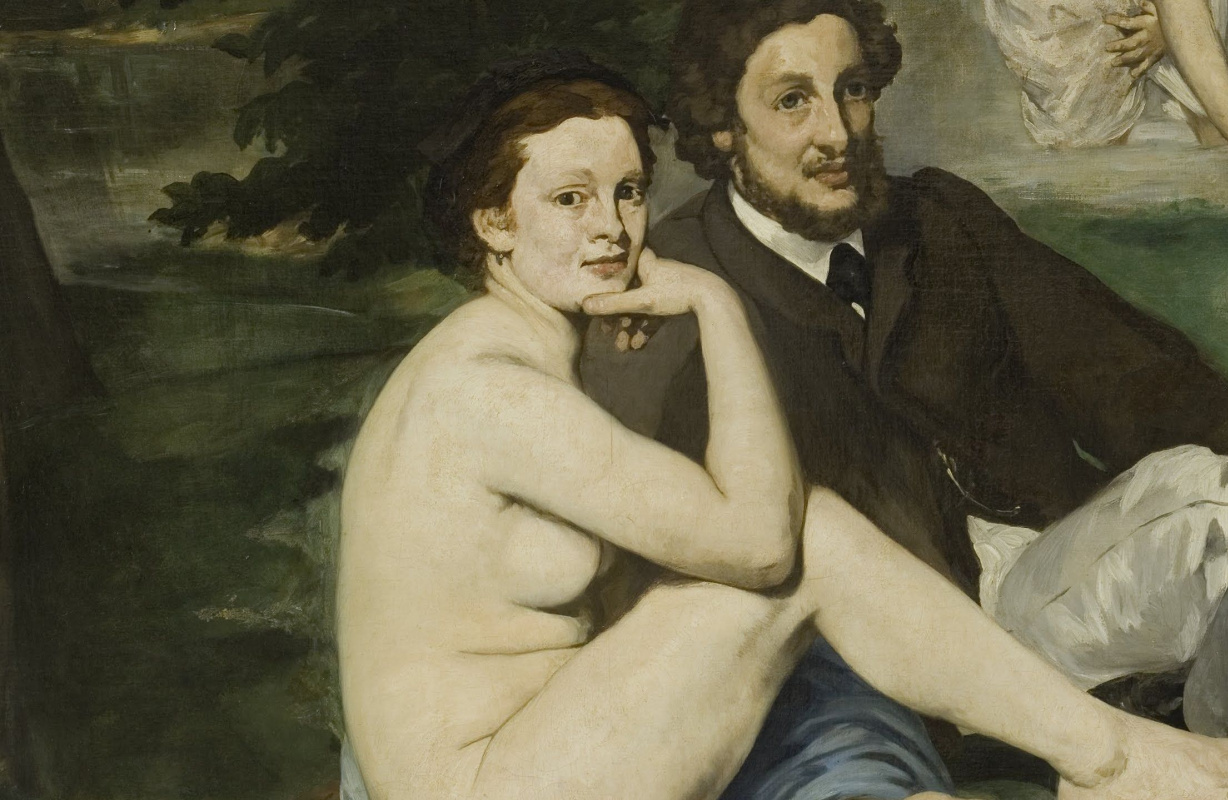
John Singer Sargent. Portrait of Madame X
Madame X (Madame Gautreau)
1884, 208.6×109.9 cm
In 1884, John Singer Sargent finished the portrait of Virginie Gautreau. By that point, the American Sargent had been living in France for 10 years. He built his career long and carefully: Sargent was not only a great artist, but also a born marketer. Paris was favourable to him: Sargent was a success as a portrait painter, his work went well.
Virginie Gautreau was a professional lady. Being the wife of a Parisian banker, she had a stormy personal life, was known as a fashion icon, a demi-mondaine, "a symbol of the beautiful era" and so on. A full-time heroine of society pages, she equally provoked public lust and irritation, unhealthy curiosity, admiration, and righteous anger. Sargent reasonably believed that the portrait of such a prominent media persona would become a significant item in his portfolio. He also had another reason: Sargent was by no means a puritan, thus he was fascinated by Madame Gautreau.
Virginie Gautreau was a professional lady. Being the wife of a Parisian banker, she had a stormy personal life, was known as a fashion icon, a demi-mondaine, "a symbol of the beautiful era" and so on. A full-time heroine of society pages, she equally provoked public lust and irritation, unhealthy curiosity, admiration, and righteous anger. Sargent reasonably believed that the portrait of such a prominent media persona would become a significant item in his portfolio. He also had another reason: Sargent was by no means a puritan, thus he was fascinated by Madame Gautreau.
Sketch for the Portrait of Madame Gautreau
When Sargent exhibited the Portrait of Madame X at the Paris Salon of 1984, he unexpectedly shook the storm. The public was indignant. Critics raged — they were nervous about the "undisguised shamelessness" (in the original version of the portrait, one strap of the dress of Madame X was flirty lowered), and the Madame’s "deadly" skin tone, and her unnaturally long nose and too red ear. The newspapers published caricatures and called Madame Gautreau the "queen of spades", alluding to the shape of her neckline. Sargent later rewrote the strap, returned it back on her shoulder, but it was too late. Virginie’s controversial reputation suffered terrible damage (she licked her wounds away from social events for several years). Sargent’s Paris career went to dust — he remained out of work and had to leave France.
Today there are many explanations for this marvelous scandal — one is more ridiculous than the other. Some believed that the pale skin and the flaming ear betrayed Virginie’s addiction to cosmetics, which was primarily used by commoners in those years, and was considered bad form in high society. Others paid too much attention to the ill-fated shoulder strap — they even staged the Strapless ballet in England in its honour. All these things, of course, sound rather naive. If Virginie used much makeup, her brilliant surroundings knew about it without the Sargent’s portrait. Moreover, it’s hard to believe that the Parisians, who had already seen paintings by Gustave Courbet or Edouard Manet, could be shocked by the lowered shoulder strap on the female shoulder.
Today there are many explanations for this marvelous scandal — one is more ridiculous than the other. Some believed that the pale skin and the flaming ear betrayed Virginie’s addiction to cosmetics, which was primarily used by commoners in those years, and was considered bad form in high society. Others paid too much attention to the ill-fated shoulder strap — they even staged the Strapless ballet in England in its honour. All these things, of course, sound rather naive. If Virginie used much makeup, her brilliant surroundings knew about it without the Sargent’s portrait. Moreover, it’s hard to believe that the Parisians, who had already seen paintings by Gustave Courbet or Edouard Manet, could be shocked by the lowered shoulder strap on the female shoulder.
Most likely, it was not about Virginie’s robe, but herself. Sargent, counting on public resonance, has not mistaken the choice of his model. He simply did not guess the direction of public opinion to swing this time. For laymen, there is no greater joy than trampling someone successful, handsome and rich into the mud. As for the Parisian aristocrats and art critics, they did not forgive Sargent his cronyism and attempts (all the more successful one) to transfer salon gossip into the context of high art.
A loose shoulder strap, a sensually flaming ear, an overly progressive (by the standards of those years) lifestyle of Virginie Gautreau — all this was appropriate and acceptable in tabloids, but not at the Paris Salon. And in the fact that Sargent called the public, absolutely recognizable persona "Madame X", there was much more dull coquetry than in all the straps of Paris. Even given that Sargent was truly talented, and Virginie Gautreau was really pretty.
A loose shoulder strap, a sensually flaming ear, an overly progressive (by the standards of those years) lifestyle of Virginie Gautreau — all this was appropriate and acceptable in tabloids, but not at the Paris Salon. And in the fact that Sargent called the public, absolutely recognizable persona "Madame X", there was much more dull coquetry than in all the straps of Paris. Even given that Sargent was truly talented, and Virginie Gautreau was really pretty.
Arkhip Kuindzhi. Moonlight Night on the Dnieper
Moonlit night on the Dnieper
1880, 105×144 cm
In the autumn of 1880, the first exhibition of one painting in the history of Russian art was held in St. Petersburg; it was Arkhip Kuindzhi’s Moonlight Night on the Dnieper. The hype around it can only be compared with what happens at today’s rock concerts or Black Friday sales. From dawn to dusk, the most motley audience pushed in a kilometer line, the newspapers reported that "all literate Petersburg had gathered here". Ilya Repin recalled how "…a continuous swarm of carriages jammed the entire street; the audience stood in a long tail on the stairs, waiting to enter, and on the street, on both sides of the sidewalk." Poets wrote poetry inspired by the painting, musicians put it to the stave.
The exhibition was organized in accordance with all the rules of modern PR — the fact that only one picture is exhibited was not only a precedent, but also gave it special weight. It was demonstrated under artificial contrast lighting — no one had done it before Kuindzhi. Among other things, the painting was purchased for a fantastic 5 thousand rubles by the Grand Duke Konstantin Konstantinovich even before the exhibition, which, of course, added fuel to the fire of public interest. And the picture itself was surprisingly good.
Despite the fact that the newspapers regularly reported about some Petersburg celebrity being hurt in the line, broken doors in the building of the Society for the Encouragement of the Arts, where the wonder of wonders was exhibited, the exposition wasn’t enough for a full-scale scandal. However, many visitors were disgraced, looking behind the frame in the hope of finding a light bulb hidden there — Kuindzhi’s Moon was realistic indeed.
The exhibition was organized in accordance with all the rules of modern PR — the fact that only one picture is exhibited was not only a precedent, but also gave it special weight. It was demonstrated under artificial contrast lighting — no one had done it before Kuindzhi. Among other things, the painting was purchased for a fantastic 5 thousand rubles by the Grand Duke Konstantin Konstantinovich even before the exhibition, which, of course, added fuel to the fire of public interest. And the picture itself was surprisingly good.
Despite the fact that the newspapers regularly reported about some Petersburg celebrity being hurt in the line, broken doors in the building of the Society for the Encouragement of the Arts, where the wonder of wonders was exhibited, the exposition wasn’t enough for a full-scale scandal. However, many visitors were disgraced, looking behind the frame in the hope of finding a light bulb hidden there — Kuindzhi’s Moon was realistic indeed.
Edouard Manet. Breakfast on the Grass
Breakfast on the grass
1863, 208×264 cm
In 1863, Edouard Manet presented to the jury of the Paris Salon his new work — Breakfast on the Grass. Two years earlier, Manet had already conquered the Salon with his Spanish Guitarist (the portrait of Auguste and Eugénie Manet, the artist’s parents, also received quite favourable reviews), and this time he had no doubt in his success. The fact that they did not take the picture to the exposition upset him. Manet did not suspect that the jury, which had made every effort to ensure that Breakfast on the Grass went unnoticed, committed an act of mercy, as his troubles were only just beginning.
On the initiative of Napoleon III, an alternative exhibition was organized — the notorious Salon des Refusés, where the ill-fated Breakfast found its place.
The idea turned out to be successful — soon the Salon des Refusés surpassed the popularity of the main exposition: the journalists joked that many artists would probably try to paint worse next year so as not to get to the Paris Salon. As for the picture by Manet, it became the absolute highlight of the program. It was anathematized and mocked. The exhibition staff had to double their vigilance — every day some moral crusader tried to pierce the "shame" with his punishing cane. Critics tried in vain to unravel the meaning of "this obscene riddle", called the picture "a slap in the face of good taste", compared it with the "ugly sore set on display".
It really was a very strange artwork. Screaming dimensions, provocative content and defiantly inept technique — it was simply impossible not to notice it. Émile Zola, who turned out to be among the defenders of the picture (of course, there were not many of them), wrote: "We see here, sadly, the most ordinary people who are guilty for having muscles and bones, like any other person. I understand the frustration and gaiety engulfing you at the sight of the canvas; maybe, you’d prefer the artist to have delighted your eyes with a picture like the ones that show off on bonbonnieres."
If we accept Zola’s arguments, the question remains, why did Manet need to quote Raphael, Giorgione and Titian and put "the most ordinary people" in the poses of shepherds or nymphs. And there is absolutely no "life truth" to explain why the local composition has such an inanimate staged appearance, the perspective is ruthlessly distorted, and the young lady swimming in the background is no less than five meters tall.
One way or another, the Breakfast on the Grass has become a synonym for art scandal, the embodiment of a standard artistic provocation, an absolute milestone. Over time, its historical value completely overshadowed any other virtues (assuming that there were any). Let Auguste and Eugénie Manet this time have had to be proud of their son not so loudly as in 1861 — Edouard quite succeeded in his epatage.
On the initiative of Napoleon III, an alternative exhibition was organized — the notorious Salon des Refusés, where the ill-fated Breakfast found its place.
The idea turned out to be successful — soon the Salon des Refusés surpassed the popularity of the main exposition: the journalists joked that many artists would probably try to paint worse next year so as not to get to the Paris Salon. As for the picture by Manet, it became the absolute highlight of the program. It was anathematized and mocked. The exhibition staff had to double their vigilance — every day some moral crusader tried to pierce the "shame" with his punishing cane. Critics tried in vain to unravel the meaning of "this obscene riddle", called the picture "a slap in the face of good taste", compared it with the "ugly sore set on display".
It really was a very strange artwork. Screaming dimensions, provocative content and defiantly inept technique — it was simply impossible not to notice it. Émile Zola, who turned out to be among the defenders of the picture (of course, there were not many of them), wrote: "We see here, sadly, the most ordinary people who are guilty for having muscles and bones, like any other person. I understand the frustration and gaiety engulfing you at the sight of the canvas; maybe, you’d prefer the artist to have delighted your eyes with a picture like the ones that show off on bonbonnieres."
If we accept Zola’s arguments, the question remains, why did Manet need to quote Raphael, Giorgione and Titian and put "the most ordinary people" in the poses of shepherds or nymphs. And there is absolutely no "life truth" to explain why the local composition has such an inanimate staged appearance, the perspective is ruthlessly distorted, and the young lady swimming in the background is no less than five meters tall.
One way or another, the Breakfast on the Grass has become a synonym for art scandal, the embodiment of a standard artistic provocation, an absolute milestone. Over time, its historical value completely overshadowed any other virtues (assuming that there were any). Let Auguste and Eugénie Manet this time have had to be proud of their son not so loudly as in 1861 — Edouard quite succeeded in his epatage.
Edouard Manet. Olympia
Olympia
1863, 130.5×190 cm
The Breakfast on the Grass made Edouard Manet a totally famous person. The Olympia painted in the same year strengthened this scandalous glory. Like a truly artistic person, Manet was torn by contradictions. Revolting against the principles, he longed for recognition. He was an idol and role model for the refusés and wanted to conquer the Paris Salon "from the front door" by all means. Every now and then, he strove to whip the audience on their cheeks, and was seriously upset when they gave him back. While working on Olympia, he perfectly understood that he went far beyond the framework of not only the tradition of those years, but also elementary decency — after all, he intended it such way. But he decided to show it only two years later (they say that Baudelaire finally pushed him to this — the man who also knew firsthand what public censure was). In 1865, Olympia was exhibited at the Paris Salon: Manet’s wish came true again, although not quite as he had expected.
The audience, remembering how fun it was in 1863, went especially to Manet in high spirits, just as experienced moviegoers go to a sequel to their favorite comedy. The audience wanted to be indignant, perplexed, wished to laugh, feel a piercing secondhand embarrassment and brandish with the gavel of justice. And Manet more than lived up to the hype: the scandal over Olympia was not inferior to the hype around the Breakfast on the Grass.
In general, Manet kept his course: like a good boxer, he beat the spots he beat in the last round. The main dish was female nudity again, the heroine again shamelessly looked straight into the eyes of the viewer, she again did not hide herself in clothing or a mythological subject, her resemblance of Victorine Meurent (Manet's constant model and mistress) were still seen — this undoubtedly added pungency to the scandal. The space of the picture was again lifelessly flat — Manet was again scolded not only for decadent shamelessness, but also because he was a nasty artist. "Never before has anyone seen anything more cynical than this Olympia. This is a female gorilla made of rubber and depicted completely naked on the bed" — this is a typical statement from the newspapers of that time.
It is no surprise that the audience went nuts on Manet’s picture again, despite the fact that armed guard was put up next to her. In the end, the directorate of the Salon had to take desperate measures: the picture was transferred to the farthest hall, to such a height where it was neither reachable even with the longest cane, nor even clearly seen.
"The fame that Manet won with his Olympia and the courage that he showed can only be compared with the those of Garibaldi," said Edgar Degas, a devoted friend and, probably, the most patient and supportive critic of Edouard Manet.
The audience, remembering how fun it was in 1863, went especially to Manet in high spirits, just as experienced moviegoers go to a sequel to their favorite comedy. The audience wanted to be indignant, perplexed, wished to laugh, feel a piercing secondhand embarrassment and brandish with the gavel of justice. And Manet more than lived up to the hype: the scandal over Olympia was not inferior to the hype around the Breakfast on the Grass.
In general, Manet kept his course: like a good boxer, he beat the spots he beat in the last round. The main dish was female nudity again, the heroine again shamelessly looked straight into the eyes of the viewer, she again did not hide herself in clothing or a mythological subject, her resemblance of Victorine Meurent (Manet's constant model and mistress) were still seen — this undoubtedly added pungency to the scandal. The space of the picture was again lifelessly flat — Manet was again scolded not only for decadent shamelessness, but also because he was a nasty artist. "Never before has anyone seen anything more cynical than this Olympia. This is a female gorilla made of rubber and depicted completely naked on the bed" — this is a typical statement from the newspapers of that time.
It is no surprise that the audience went nuts on Manet’s picture again, despite the fact that armed guard was put up next to her. In the end, the directorate of the Salon had to take desperate measures: the picture was transferred to the farthest hall, to such a height where it was neither reachable even with the longest cane, nor even clearly seen.
"The fame that Manet won with his Olympia and the courage that he showed can only be compared with the those of Garibaldi," said Edgar Degas, a devoted friend and, probably, the most patient and supportive critic of Edouard Manet.
Claude Monet. Impression, Sunrise
Impression. Sunrise
1872, 48×63 cm
In 1874, a group of artists from the so-called Batignolles School decided that it was time to go their own way. The next economic crisis was coming; most of them were in dire need of money. At that time, Edgar Degas was the ideological leader of the "Manet Gang", previously ruled by his friend (Manet himself continued to assail the Paris Salon and was completely absorbed in this). Degas hated everything that was connected with the official Salon. In a word, it was decided to organize their own vernissage.
The training revealed a number of disagreements among like-minded people. Degas wanted to call artists from the outside (so as not to be known as radicals and save on rent), while his young colleagues longed for revolutions. The socialist Pissarro wanted to organize a cooperative following the example of Parisian bakers. Edouard Manet, who, of course, was invited, demanded that Cézanne be removed from the lists.
Edmond, the brother of Auguste Renoir, who was entrusted with hanging the artworks, complained about the monotony of the names. When, despaired by the abundance of Monet’s morning landscapes, he asked him to come up with a different name for at least one of them, he answered: "Capture it ‘Impression' ".
The exhibition on Boulevard des Capucines could have gone unnoticed if art critic Louis Leroy had not clung to this name, had not burst into a caustic article, and had not coined the term "impressionism".
The Leroy’s devastating text made the exhibitors and himself famous. A lot of time passed before the word "impressionism" ceased to sound like a mockery in the context of fine art, and the fleur of scandalism around it completely disappeared.
Auguste Renoir worried because of the article by Leroy more than others. After all, according to the recollections of his son Jean, he was least vilified there.
The training revealed a number of disagreements among like-minded people. Degas wanted to call artists from the outside (so as not to be known as radicals and save on rent), while his young colleagues longed for revolutions. The socialist Pissarro wanted to organize a cooperative following the example of Parisian bakers. Edouard Manet, who, of course, was invited, demanded that Cézanne be removed from the lists.
Edmond, the brother of Auguste Renoir, who was entrusted with hanging the artworks, complained about the monotony of the names. When, despaired by the abundance of Monet’s morning landscapes, he asked him to come up with a different name for at least one of them, he answered: "Capture it ‘Impression' ".
The exhibition on Boulevard des Capucines could have gone unnoticed if art critic Louis Leroy had not clung to this name, had not burst into a caustic article, and had not coined the term "impressionism".
The Leroy’s devastating text made the exhibitors and himself famous. A lot of time passed before the word "impressionism" ceased to sound like a mockery in the context of fine art, and the fleur of scandalism around it completely disappeared.
Auguste Renoir worried because of the article by Leroy more than others. After all, according to the recollections of his son Jean, he was least vilified there.
Leonardo da Vinci. Salvator Mundi (Savior of the World)
Salvator Mundi (Savior of the World)
1500, 65.7×45.7 cm
The scandalous fame overtook the Savior of the World (the picture supposedly belongs to the hand of Leonardo da Vinci) about 500 years after it was painted. For a long time it was considered leonardesque, a work of a copycat, at best, one of Leonardo’s students. In this status, at the beginning of the last century, the picture was acquired by the famous English collector Baronet Frederick Cook. In 1958, Cook’s heirs sold the Savior of the World at Sotheby’s auction — they managed to gain triumphant 45 pounds.
In 2004, a group of art dealers acquired the painting (for about $ 10,000), and it was sent for restoration. Over several centuries, the work has undergone numerous retouches — for example, in the era of the counter-reformation, the too feminine Savior acquired His mustache and beard. Having cleaned up the layers of later retouches, the restorers found two thumbs on his right hand — the initial position of the fingers was changed, which at least testified to the seriousness of the artist’s intentions — imitators did not abuse it, as a rule. For the first time in modern history, the Savior of the World was talked of as a work to which Leonardo could be involved not only as an inspiration. The restored canvas was examined in the museums in the USA and Europe, in 2011 in London it was finally attributed to Da Vinci, unanimously though.
In 2013, Russian billionaire Dmitry Rybolovlev acquired the picture for 127 million dollars. And two years later, a full-fledged scandal erupted. Rybolovlev accused his art dealer Yves Bouvier of overpricing. In addition, Rybolovlev claimed that Bouvier made a fraudulent arrangement with the Sotheby’s auction house. Against the background of the process, the doubts of some experts in the authorship of Leonardo da Vinci sounded even more significant. However, when Rybolovlev put the picture up for auction (in order to compensate his damage somehow), it suddenly had been sold for 450 million. The price step at Christie’s auction was unprecedented 40 million, and the final price was an absolute record. If those present were not so passionate about bidding, they would probably have noticed how the Savior smiled, winked and raised his thumbs up — all three of them.
The painting was bought anonymously. According to rumors, it was acquired by the Saudi Prince Badr bin Abdullah bin Mohammed bin Farhan Al Saud. Immediately after the auction, the Savior of the World disappeared. Its next coming was expected in vain at an exhibition in the Paris Louvre, dedicated to the 500th anniversary of the death of Leonardo. The painting was to be exhibited at the Louvre branch in Abu Dhabi, but it also did not appear there. Regarding the true motives for its purchase, many hypotheses were expressed, including quite paranoid ones. They said that the Christian shrine was bought by religious fanatics in order to destroy it. Or that the Savior was needed by the Prince for political blackmail. And, for example, the French expert Jacques Frank believes that the painting is hidden in order to hide the greatest scam in history — the mediocre imitation of Leonardo has become the most expensive painting in the history of mankind.
In 2004, a group of art dealers acquired the painting (for about $ 10,000), and it was sent for restoration. Over several centuries, the work has undergone numerous retouches — for example, in the era of the counter-reformation, the too feminine Savior acquired His mustache and beard. Having cleaned up the layers of later retouches, the restorers found two thumbs on his right hand — the initial position of the fingers was changed, which at least testified to the seriousness of the artist’s intentions — imitators did not abuse it, as a rule. For the first time in modern history, the Savior of the World was talked of as a work to which Leonardo could be involved not only as an inspiration. The restored canvas was examined in the museums in the USA and Europe, in 2011 in London it was finally attributed to Da Vinci, unanimously though.
In 2013, Russian billionaire Dmitry Rybolovlev acquired the picture for 127 million dollars. And two years later, a full-fledged scandal erupted. Rybolovlev accused his art dealer Yves Bouvier of overpricing. In addition, Rybolovlev claimed that Bouvier made a fraudulent arrangement with the Sotheby’s auction house. Against the background of the process, the doubts of some experts in the authorship of Leonardo da Vinci sounded even more significant. However, when Rybolovlev put the picture up for auction (in order to compensate his damage somehow), it suddenly had been sold for 450 million. The price step at Christie’s auction was unprecedented 40 million, and the final price was an absolute record. If those present were not so passionate about bidding, they would probably have noticed how the Savior smiled, winked and raised his thumbs up — all three of them.
The painting was bought anonymously. According to rumors, it was acquired by the Saudi Prince Badr bin Abdullah bin Mohammed bin Farhan Al Saud. Immediately after the auction, the Savior of the World disappeared. Its next coming was expected in vain at an exhibition in the Paris Louvre, dedicated to the 500th anniversary of the death of Leonardo. The painting was to be exhibited at the Louvre branch in Abu Dhabi, but it also did not appear there. Regarding the true motives for its purchase, many hypotheses were expressed, including quite paranoid ones. They said that the Christian shrine was bought by religious fanatics in order to destroy it. Or that the Savior was needed by the Prince for political blackmail. And, for example, the French expert Jacques Frank believes that the painting is hidden in order to hide the greatest scam in history — the mediocre imitation of Leonardo has become the most expensive painting in the history of mankind.
Gustave Courbet. The Bathers
Bathers
1853, 193×227 cm
They say that when Napoleon III saw the Breakfast on the Grass, he only pursed his lips contemptuously and, without uttering a word, passed by. Well, the Emperor had seen a lot by that time. According to eyewitnesses, Napoleon was less restrained before and reacted to the grimaces of "modern" art much more emotionally. For example, in 1853 (ten years before seeing the artwork by Edouard Manet) at the Paris Salon, he became so angry that he hit one of the paintings with his whip. These were the Bathers by Gustave Courbet, the picture that seemed not only chastely asexual, but also quite traditional with its bucolic subject in a pacifying landscape
. By depicting one of the "nymphs" defiantly overweight, Courbet mercifully covered her mighty backr with a piece of cloth. What infuriated Napoleon so much (and, of course, not only him)?
Of course, Courbet was reproached for the fact that his subjects had completely "non-romantic" constitution. They say that the wife of Napoleon, the Empress Eugénie, who was just looking at the picture with Percheron horses depicted, asked: "Is it Percheron too?" "The disgusting vulgarity of forms and design" was noted even by Courbet’s friend Eugène Delacroix. While Théophile Gautier did not resort to metaphors and sarcasm, he simply used the phrase "monstrous ass" in his review.
However, this was not the only and, perhaps, not the main complaint. The aristocrats could not forgive Courbet that the maidservant on his canvas had a sloppy sock and a dirty foot. Bringing dirty legs to the Louvre was too much: in such realism , socialist pathos was observed, and this was more terrible than the most monstrous forms.
Courbet was an experienced brawler; he was no stranger to fierce criticism. Previously, his Burial At Ornans already caused a storm of indignation at the same Paris Salon. Critics have not missed an opportunity to kick Courbet almost from the beginning of his career. If they knew, what Gustave would paint in the 60s (1, 2), they would save their strength.
Of course, Courbet was reproached for the fact that his subjects had completely "non-romantic" constitution. They say that the wife of Napoleon, the Empress Eugénie, who was just looking at the picture with Percheron horses depicted, asked: "Is it Percheron too?" "The disgusting vulgarity of forms and design" was noted even by Courbet’s friend Eugène Delacroix. While Théophile Gautier did not resort to metaphors and sarcasm, he simply used the phrase "monstrous ass" in his review.
However, this was not the only and, perhaps, not the main complaint. The aristocrats could not forgive Courbet that the maidservant on his canvas had a sloppy sock and a dirty foot. Bringing dirty legs to the Louvre was too much: in such realism , socialist pathos was observed, and this was more terrible than the most monstrous forms.
Courbet was an experienced brawler; he was no stranger to fierce criticism. Previously, his Burial At Ornans already caused a storm of indignation at the same Paris Salon. Critics have not missed an opportunity to kick Courbet almost from the beginning of his career. If they knew, what Gustave would paint in the 60s (1, 2), they would save their strength.
James Whistler. Nocturne in Black and Gold
Nocturne in black and gold. The falling rocket
1875, 60.3×46.6 cm
In 1877, James Whistler exhibited the painting Nocturne in Black and Gold — The Falling Rocket in the London Grosvenor Gallery. It was painted in a distinctly impressionistic manner and perfectly characterized the Whistler’s views on painting of that time. He believed that he had the right to paint not the Thames, not the park on its shore, not the night fireworks, but the feeling of all this. Unsteady, obscure, fading away like a dream or a trace left in a dark sky by a rocket — for if he wanted clear silhouettes and intelligible statements, he would become a photographer, not an artist.
These views were not shared by everyone. For example, authoritative art critic John Ruskin published a review in a London newspaper, in which he wrote: "I heard a lot about shamelessness and conceit of Cockney. But I didn’t think that I would see a smug buffoon demanding two hundred guineas for splashing out paint from a pot into the face of the public."
The review was not a reason for a full-fledged scandal. However, Whistler decided to fight back, and filed a lawsuit against Ruskin for defamation. In the end, he poured paint on no one. Yes, and Ruskin, born in London, was much more cockney than the American Whistler.
The argument lasted about a year. Whistler’s reputation was seriously damaged, many customers and patrons turned their backs on him. His precarious financial situation was finally undermined by legal costs. Whistler had to declare himself bankrupt and sell the property under the hammer.
As a result, he won a Pyrrhic victory: the court ruled in his favour, awarding the artist a humorous compensation of a quarter pence (Whistler claimed 1,000 pounds). Later, based on this art scandal, James Whistler would write the book "The Fine Art of Making Enemies".
As for Ruskin, he never appeared at the hearing. His mental health was greatly shaken — perhaps the Nocturne in Black and Gold played its role in this.
These views were not shared by everyone. For example, authoritative art critic John Ruskin published a review in a London newspaper, in which he wrote: "I heard a lot about shamelessness and conceit of Cockney. But I didn’t think that I would see a smug buffoon demanding two hundred guineas for splashing out paint from a pot into the face of the public."
The review was not a reason for a full-fledged scandal. However, Whistler decided to fight back, and filed a lawsuit against Ruskin for defamation. In the end, he poured paint on no one. Yes, and Ruskin, born in London, was much more cockney than the American Whistler.
The argument lasted about a year. Whistler’s reputation was seriously damaged, many customers and patrons turned their backs on him. His precarious financial situation was finally undermined by legal costs. Whistler had to declare himself bankrupt and sell the property under the hammer.
As a result, he won a Pyrrhic victory: the court ruled in his favour, awarding the artist a humorous compensation of a quarter pence (Whistler claimed 1,000 pounds). Later, based on this art scandal, James Whistler would write the book "The Fine Art of Making Enemies".
As for Ruskin, he never appeared at the hearing. His mental health was greatly shaken — perhaps the Nocturne in Black and Gold played its role in this.






